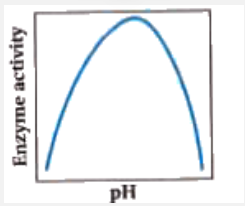How are prosthetic groups different from co-factors ?Solution in Gujrati
Prosthetic groups are organic compound, links strongly with apoenzyme co-factors are small, nonprotein organic/inorganic co-factors when loosely links with enzymes are known as coenzymes and when strongly links with apoenzyme known as prosthetic group.
Topper's Solved these Questions
- BOOK - KUMAR PRAKASHANCHAPTER - BIOMOLECULES EXERCISE - SECTION -E SOLUTION OF NCERT EXEMPLAR (SHORT ANSWER TYPE QUESTIONS)5videos
BIOMOLECULES
- BOOK - KUMAR PRAKASHANCHAPTER - BIOMOLECULES EXERCISE - SECTION -E SOLUTION OF NCERT EXEMPLAR (LONG ANSWER TYPE QUESTIONS):5videos
BIOMOLECULES
- BOOK - KUMAR PRAKASHANCHAPTER - BIOMOLECULES EXERCISE - SECTION -E SOLUTION OF NCERT EXEMPLAR (MULTIPLE CHOICE QUESTIONS (MCQS))14videos
BIOMOLECULES
- BOOK - KUMAR PRAKASHANCHAPTER - BIOLOGICAL CLASSIFICATIONEXERCISE - OBJECTIVE SECTION (FILL IN THE BLANKS)10videos
BIOLOGICAL CLASSIFICATION
- BOOK - KUMAR PRAKASHANCHAPTER - BODY FLUIDS AND CIRCULATIONEXERCISE - BODY FLUIDS AND CIRCULATION (FILL IN THE BLANKS )10videos
BODY FLUIDS AND CIRCULATION
Similar Questions
Enzymes are proteins. Proteins are long chains of amino acids linked to each other by peptide bonds. Amino acids have many functional groups in their structure.

These functional groups are many of them at least, ionisable. As they are weak acids and bases in chemical nature, this ionisation is influenced by pH of the solution. For many enzymes activity is influenced by surrounding pH. This is depicted in the curve below, explain briefly.02:44View SolutionFormation of Enzyme substrate complex (ES) is the first step in the catalysed reactions. Describe the other steps till the formation of product.
04:28View SolutionIt is said that elemental composition of living organisms and that of inanimate objects (like earth's crust) are similar in the sense that all the major elements are present in both. Then what would be the difference between these two groups ? Choose a correct answer from among the following.
(A) Living organisms have more gold in them than inanimate objects.
(B) Living organisms have more water in their body than inanimate objects.
(C) Living organisms have more carbon, oxygen and hydrogen per unit mass than inanimate objects.
(D) Living organisms have more calcium in them than inanimate objects.02:21View SolutionFill in the blanks
In diatoms the cell walls form two thin overlapping shell which fit together as in .......03:05View Solution...... ions play a very important role in clotting.
02:15View SolutionHow are prosthetic groups different from co-factors?
03:07View SolutionAssertion : Coenzymes serve as co-factors in a number of different enzyme catalyzed reactions. Reason : Coenzymes and prosthetic groups are cofactors.
04:19View SolutionDifference between prosthetic group and co-enzyme.
04:14View Solutionयोजीप्रेरक (प्रोस्थेटिक) समूह सह-कारकों से किस प्रकार भिन्न होते हैं ?
03:41View Solutionসংজ্ঞা দাও: A. প্রস্থেটিক গ্রুপ, B. কো-ফ্যাক্টর।
03:11View SolutionCo- factor and prosthetic groups are ………... compounds, …………... bound to apoenzyme.
02:15View SolutionProsthetic groups differ from co-factors in that the former is
02:15View SolutionList one difference between prosthetic group and coenzyme.
03:39View SolutionDifferentiate between prosthetic group and co-enzyme.
02:12View SolutionHow are prosthetic groups different from co-factors?
02:09View Solution
